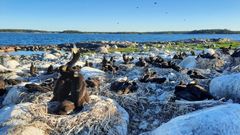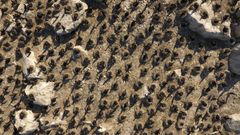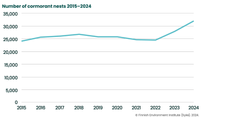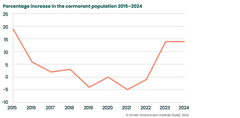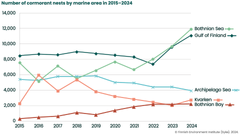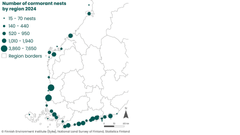Finland’s Great Cormorant population grew by more than ten per cent
Approximately 31,950 cormorant (Phalacrocorax carbo sinensis) nests were counted in Finland during the summer 2024. The Finnish breeding population increased by 14 per cent (about 4,035 nests) from the previous summer. Apparently, the influx of cormorants from other Baltic Sea countries started already in the previous year and has now increased the breeding population by about a quarter after a relatively stable period in 2015–2022. The aim of long-term monitoring and research is to support socially, ecologically, and economically sustainable coexistence with cormorants by providing high-quality information.
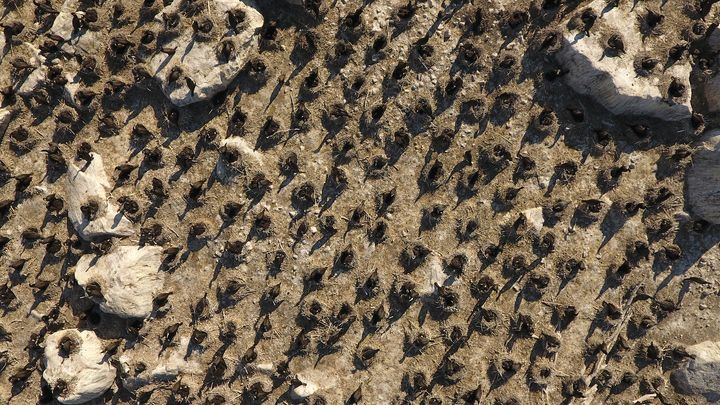
Like in the previous year, the increase of the cormorant population was concentrated to the southern Bothnian Sea and the Gulf of Finland, where the increase was 28 and 16 %, ca 2,500 and 1,500 nests, respectively. After a five-year period of decline the number of nests in the Kvarken increased about 720 nests. In contrast, the population of the Archipelago Sea, where the white-tailed eagle (Haliaeetus albicilla) is most abundant, continued to decline, with about 480 fewer nests than in the previous summer and almost 2,000 fewer than in 2019. In the Bothnian Bay, the number of nests remained nearly unchanged.
"The Estonian cormorant population doubled to about 33,600 breeding pairs during 2015–2022 and the Swedish breeding population has also increased significantly, while populations in the southern Baltic Sea have remained fairly stable. It is obvious that the strong increase of cormorant populations in the neighboring countries is now reflected as an influx to the Finnish population", says researcher Pekka Rusanen from the Finnish Environment Institute Syke.
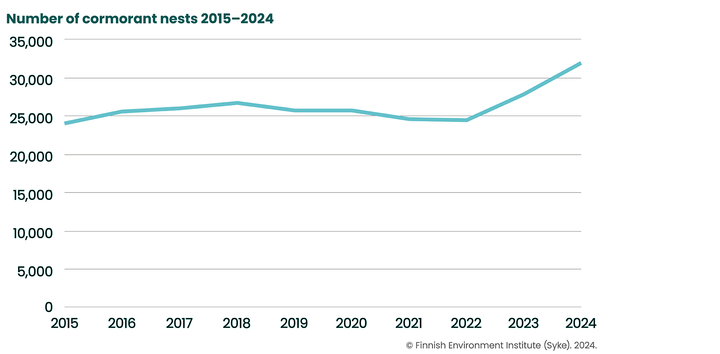
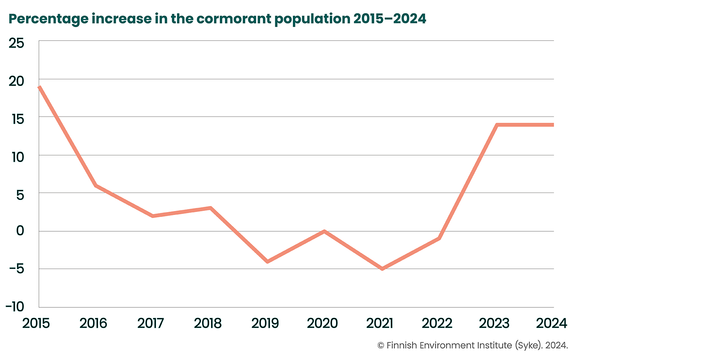
The cormorant population of the Gulf of Bothnia increased by a fifth. The Gulf of Bothnia included about 16,900 nests, of which 11,900 in the Bothnian Sea, 2,750 in the Kvarken and 2,250 in the Bothnian Bay. The Gulf of Finland included about 11,090 nests and the Archipelago Sea 3,950 nests. Only one inland colony was observed comprising fourteen nests in Päijänne-Tavastia.
The Bothnian Sea and the Gulf of Finland accounted for 37 and 35 % of all the Finnish cormorant nests, respectively. The Archipelago Sea accounted for 12% and the Kvarken and the Bothnian Bay for 9 and 7 %, respectively.
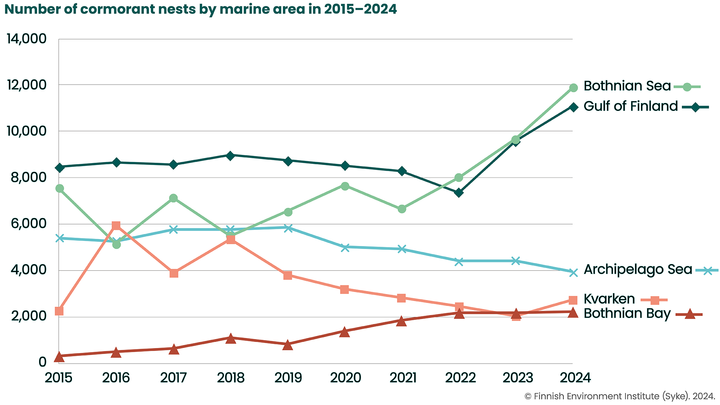
The six largest colonies house half of the breeding population
Altogether 62 cormorant colonies were observed, on 93 islands or islets and eight colonies in small groups at sea marks, line markers or lighthouses.
The six largest colonies accounted for half of the entire Finnish cormorant population. The colony at the port of Rauma, southern Bothnian Sea, where about 7,650 nests were counted, included almost a quarter of all breeding cormorants. The next nine largest colonies, each with 1,000–1,900 nests, were located in the Vaasa, Pori (2 colonies), Turku, Raasepori, Kirkkonummi, Espoo, Porvoo and Hamina municipalities.
The cormorant colony at the port of Rauma is the largest bird colony ever recorded in Finland. The colony was also home to a pair of white-tailed eagles for the fourth year in a row.
"The natural development of the colony now depends mainly on the abundance of fish suitable for the chicks, as well as on whether the white-tailed eagles continue to breed in the colony”, says Rusanen. “The breeding pair of eagles protects the cormorant colony from predation by non-breeding young eagles. This predation has repeatedly proven fatal for many large colonies. When chick production collapses the adult cormorants will seek new breeding grounds.”
At the municipal level, cormorant breeding numbers increased most in Pori (1,735 nests), Vaasa (1,490 nests), Rauma (820 nests) and Siikajoki (575 nests). The only larger colony of Vaasa returned to its old breeding islet after two years of absence, and nearly the whole population of the northern Bothnian Bay moved from Oulu to Siikajoki. Both Espoo, Loviisa and Hamina included 375–430 more nests than in the previous summer.
The population decreased most in Mustasaari municipality by 810 nests. Both Kristiinankaupunki, Uusikaupunki and Turku included 200–300 fewer nests than in the previous summer.
The land area covered by cormorant breeding colonies was about 76 hectares. The proportion of tree-nesting cormorants continued to increase and accounted for more than 60% of the total number of nests, compared with only a quarter five years earlier. Breeding in inner archipelago, closer to settlements and in trees, has increased with the increased predation of white-tailed eagles.
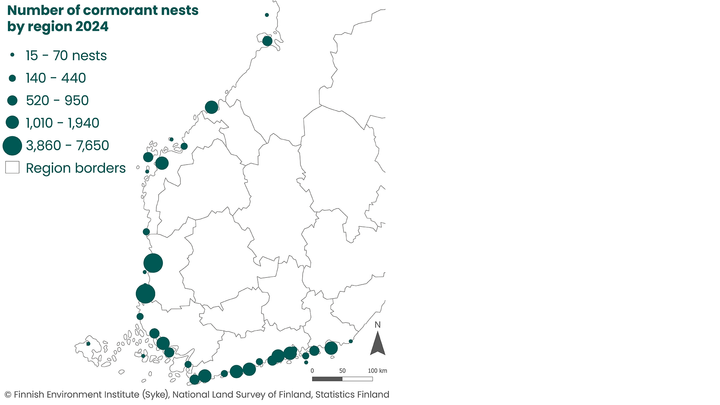
Only a few colonies were deserted
This year, only four colonies that were inhabited in the previous year, were deserted. Thirteen entirely new or recolonized colonies were found. The eight completely new colonies located in Kokkola, Vöyri, Korsnäs, Finström, Naantali, Kirkkonummi, Porvoo and Loviisa municipalities, comprising together about 340 nests.
Illegal harassment of cormorant colonies occurred this summer at least in Kristiinankaupunki, Pori, Masku, Sipoo, Pyhtää and Hamina municipalities. Of these, nesting failed completely in Hamina. Also, in Vöyri and Finström nesting failed apparently due to illegal disturbance.
Cormorant is a returnee species
The cormorant is protected in Finland around the year under the Nature Conservation Act and is not on the EU's list of huntable species. In the Baltic Sea the cormorant has returned to its original breeding grounds and is not handled in Finland´s National Strategy on Invasive Alien Species.
Monitoring of the cormorant population is coordinated by the Finnish Environment Institute Syke. The monitoring collects basic information on the ecology and distribution of the species. We warmly thank all the 80 people who participated in the census, search, and inspection of cormorant colonies in the summer of 2024!
Keywords
Contacts
Pekka Rusanen, Researcher, Finnish Environment Institute Syke, tel. +358 400 148 691,
firstname.lastname@syke.fi
Aleksi Mikola, Researcher, Finnish Environment Institute Syke, tel. +358 50 328 7588,
firstname.lastname@syke.fi
Media service at Finnish Environment Institute
Our Media Service provides information on research, helps journalists find experts for interviews and provides photos for media use.
Our Communication experts will answer your inquiries on weekdays from 9 am to 4 pm.
Images
Documents
Links
Finnish Environment Institute - We build hope through research.
Finnish Environment Institute
Latokartanonkaari 11
00790 Helsinki
+358 295 251 000
It is time to move beyond solving environmental problems one by one, to systemic sustainability transformations. The Finnish Environment Institute (Syke) contributes to building a sustainable society through research, information and services. The Finnish Environment Institute is a research institute with 700 experts and researchers located in Helsinki, Oulu, Jyväskylä and Joensuu.

Subscribe to releases from Suomen ympäristökeskus
Subscribe to all the latest releases from Suomen ympäristökeskus by registering your e-mail address below. You can unsubscribe at any time.
Latest releases from Suomen ympäristökeskus
Kommunernas konsumtionsbaserade utsläpp långt ifrån en hållbar nivå17.12.2024 06:01:00 EET | Pressmeddelande
Finlands miljöcentral (Syke) har publicerat alla finländska kommuners konsumtionsbaserade växthusgasutsläpp från 2019. Enligt resultaten är kommunerna i Finland mycket långt ifrån hållbar konsumtion.
Kuntien kulutusperäiset päästöt kaukana kestävästä tasosta17.12.2024 06:01:00 EET | Tiedote
Suomen ympäristökeskus (Syke) on julkaissut kaikkien Suomen kuntien kulutusperäiset kasvihuonekaasupäästöt vuodelta 2019. Tulosten mukaan Suomen kunnissa ollaan hyvin kaukana kestävästä kulutuksesta.
Hushållen behövs för klimattalko - Den förnyade räknaren Klimatdiet.fi hjälper till att bedöma det egna koldioxidavtrycket17.12.2024 06:00:00 EET | Pressmeddelande
Hushållens koldioxidavtryck har minskat betydligt under 2000-talet, från cirka 14 ton koldioxidekvivalenter (CO2e) till 7,7 ton. Orsaken är dock inte att finländarnas konsumtionsvanor skulle ha förändrats, utan att växthusgasutsläppen från produktionen minskat både i Finland och utomlands.
Kotitalouksia tarvitaan ilmastotalkoisiin - Uudistunut Ilmastodieetti.fi-laskuri auttaa arvioimaan oman hiilijalanjäljen17.12.2024 06:00:00 EET | Tiedote
Kotitalouksien hiilijalanjälki on laskenut tuntuvasti 2000-luvulla noin 14 hiilidioksidiekvivalenttitonnista (CO2e) 7,7 tonniin. Syynä ei kuitenkaan ole suomalaisten kulutustottumusten muutos vaan tuotannon kasvihuonekaasupäästöjen väheneminen niin Suomessa kuin ulkomailla. Suomen ympäristökeskus on päivittänyt Ilmastodieetti.fi-työkalun, jolla kotitaloudet voivat laskea oman kulutuksensa hiilijalanjäljen.
Kysely: suomalaisilta vahva tuki puhtaalle energiasiirtymälle10.12.2024 06:00:00 EET | Tiedote
Suomalaiset tukevat puhdasta energiasiirtymää, kertovat Suomen ympäristökeskuksen kyselytutkimukset. Tuuli- ja aurinkoenergiaan suhtaudutaan myönteisesti ja enemmistö vastanneista kannattaa myös ydinvoiman lisäämistä. Vesivoima ja puunkäyttö energiantuotannossa jakavat mielipiteitä. Hiili- ja turvevoiman perään kansalaiset eivät juurikaan haikaile.
In our pressroom you can read all our latest releases, find our press contacts, images, documents and other relevant information about us.
Visit our pressroom
